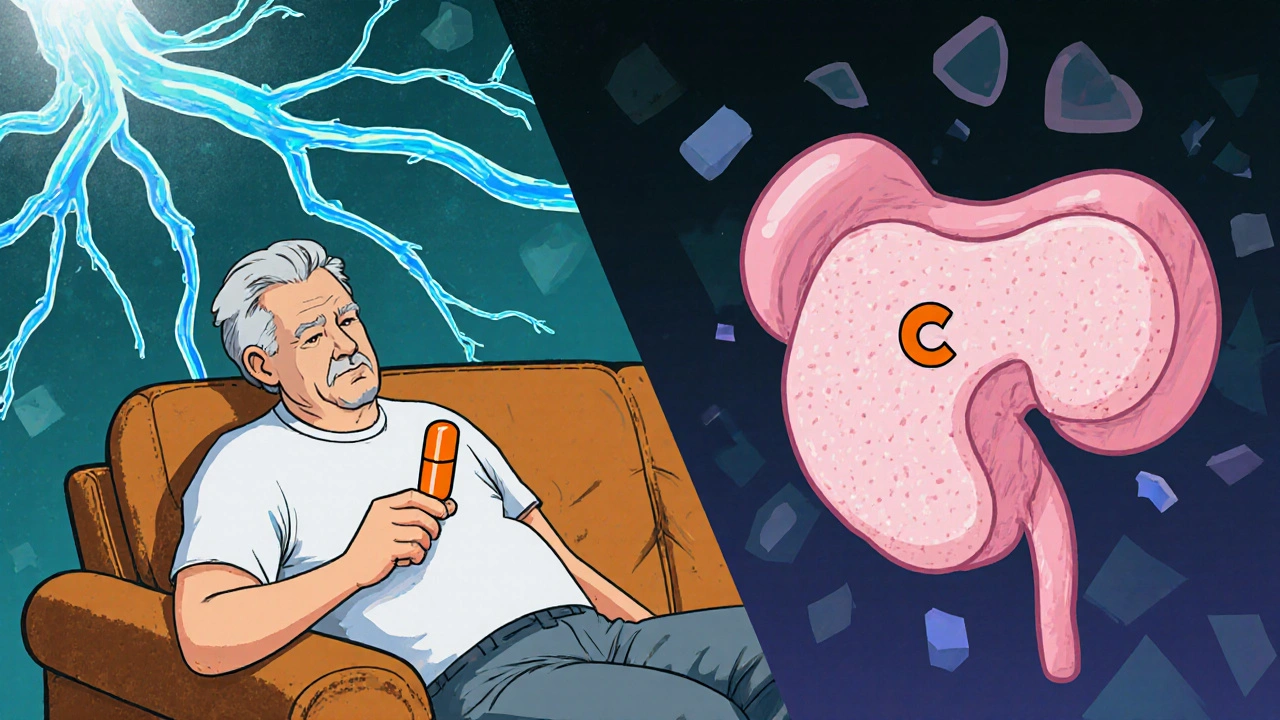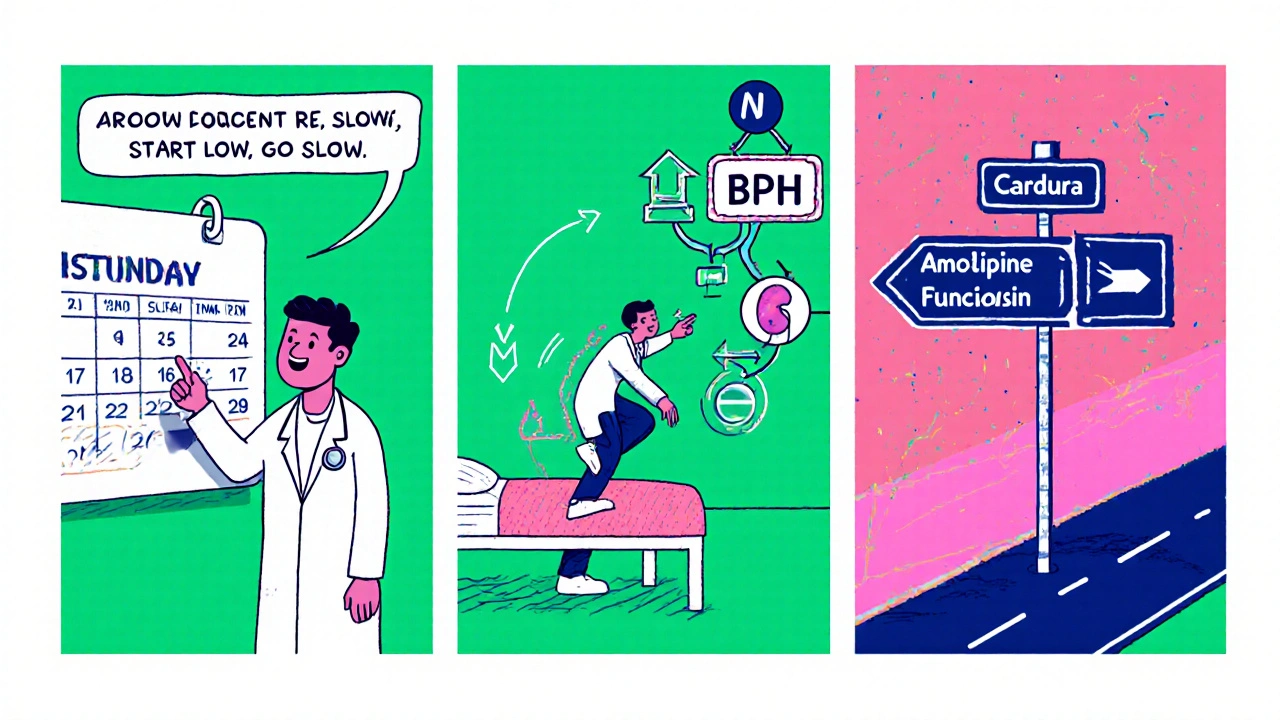 Oct, 19 2025
Oct, 19 2025
Quick Takeaways
- Cardura (doxazosin) is an alpha‑blocker used for hypertension and benign prostatic hyperplasia (BPH).
- It shares the same class with prazosin and terazosin but differs in half‑life and dosing flexibility.
- For pure blood‑pressure control, calcium‑channel blockers (e.g., amlodipine) or ACE inhibitors (e.g., lisinopril) often have smoother side‑effect profiles.
- When BPH symptoms dominate, tamsulosin provides more prostate‑focused relief with fewer orthostatic drops.
- Choosing the right drug hinges on the primary indication, tolerance to side effects, and any existing comorbidities.
What is Cardura (Doxazosin)?
Cardura is a prescription medication whose active ingredient is doxazosin. It belongs to the alpha‑adrenergic blocker class, meaning it relaxes smooth muscle in blood vessels and the prostate by blocking alpha‑1 receptors. First approved by the FDA in 1995, Cardura quickly found a niche treating both high blood pressure and the urinary symptoms of benign prostatic hyperplasia (BPH).
Typical dosing starts at 1 mg once daily for hypertension, with a gradual increase to a maximum of 16 mg per day. For BPH, the usual dose is 4 mg at bedtime, sometimes titrated up to 8 mg.
How Cardura Works
Alpha‑1 receptors line the walls of peripheral arteries and the prostate’s stromal tissue. When doxazosin blocks these receptors, two things happen:
- Vasodilation reduces systemic vascular resistance, lowering blood pressure.
- Relaxation of prostate smooth muscle eases urinary flow, mitigating BPH‑related urgency and nocturia.
This dual action is why Cardura is often chosen for patients who need both antihypertensive therapy and BPH relief.
Alternatives at a Glance
Because Cardura sits in the broader alpha‑blocker family, it makes sense to compare it with sibling drugs and with agents from other antihypertensive classes.
- Prazosin - an older alpha‑blocker primarily used for hypertension; short half‑life (2-3 hours).
- Terazosin - similar to Cardura but with a slightly longer half‑life (10-12 hours) and a once‑daily dosing regimen.
- Tamsulosin - a selective alpha‑1A blocker targeting the prostate, minimal impact on blood pressure.
- Amlodipine - a calcium‑channel blocker used solely for hypertension and angina, known for a smooth side‑effect profile.
- Lisinopril - an ACE inhibitor that reduces blood pressure by inhibiting the renin‑angiotensin system, often first‑line for diabetics.
Two broader conditions drive the choice of any of these drugs: Hypertension and Benign Prostatic Hyperplasia (BPH). Understanding how each alternative addresses these conditions is essential.
Side‑Effect Landscape
All alpha‑blockers share a characteristic “first‑dose” phenomenon: a sudden drop in blood pressure that can cause dizziness or fainting, especially when standing up (orthostatic hypotension). Cardura’s longer half‑life softens this effect compared with prazosin, but the risk remains.
Typical side‑effects by drug class:
- Cardura / Terazosin: Dizziness, headache, edema, fatigue.
- Prazosin: More pronounced first‑dose drop, nasal congestion.
- Tamsulosin: Retrograde ejaculation, mild dizziness.
- Amlodipine: Peripheral edema, gingival hyperplasia (rare).
- Lisinopril: Dry cough, hyperkalemia, angioedema (rare).
Choosing the right medication often comes down to which side‑effect profile the patient can tolerate.
Direct Comparison Table
| Drug | Primary Indication(s) | Typical Dose Range | Half‑Life | Common Side‑Effects | Approx. Monthly Cost (USD) |
|---|---|---|---|---|---|
| Cardura (doxazosin) | Hypertension, BPH | 1‑16 mg daily | 16‑30 h | Dizziness, headache, edema | 20‑30 |
| Prazosin | Hypertension | 1‑10 mg daily | 2‑3 h | Orthostatic hypotension, nasal congestion | 15‑25 |
| Terazosin | Hypertension, BPH | 1‑10 mg daily | 10‑12 h | Dizziness, fatigue, edema | 18‑28 |
| Tamsulosin | BPH only | 0.4 mg daily | 9‑13 h | Retrograde ejaculation, mild dizziness | 22‑35 |
| Amlodipine | Hypertension, angina | 2.5‑10 mg daily | 35‑50 h | Peripheral edema, gingival overgrowth | 12‑20 |
| Lisinopril | Hypertension, heart failure | 5‑40 mg daily | 12‑14 h | Cough, hyperkalemia, angioedema | 8‑15 |
When to Choose Cardura
If a patient presents with both uncontrolled blood pressure and moderate‑to‑severe BPH symptoms, Cardura often eliminates the need for two separate prescriptions. It also fits well when:
- The clinician prefers a once‑daily regimen without the need for a separate nighttime dose.
- The patient has already tried a calcium‑channel blocker but still experiences prostate enlargement.
- Renal function is stable, as doxazosin is eliminated primarily unchanged via the kidneys and does not accumulate in liver disease.
Conversely, avoid Cardura if the patient has a history of severe orthostatic hypotension, is on multiple antihypertensives that already cause low blood pressure, or is prone to dizziness.
Practical Tips & Common Pitfalls
- Start Low, Go Slow: Begin with 1 mg for hypertension or 4 mg for BPH. Increase weekly to gauge tolerance.
- Take at the Same Time Every Day: Consistency minimizes fluctuations in plasma levels.
- Watch the First‑Dose Effect: Counsel patients to rise slowly from sitting or lying positions for the first week.
- Check for Drug Interactions: Avoid combining with other alpha‑blockers or potent CYP3A4 inhibitors (e.g., ketoconazole) without dose adjustment.
- Monitor Labs: Periodic renal function tests and electrolytes are prudent, especially if the patient is on diuretics.
Missing any of these steps can lead to avoidable side‑effects or sub‑optimal blood‑pressure control.
Bottom Line
Cardura shines when you need a single pill to address both hypertension and BPH. Its longer half‑life and once‑daily dosing give it an edge over prazosin, while its broader indication set beats tamsulosin for patients without isolated prostate issues. However, for pure blood‑pressure control, drugs like amlodipine or lisinopril often provide smoother tolerability. Always weigh the primary clinical goal, side‑effect tolerance, and any comorbid conditions before settling on a regimen.

Can Cardura be used for patients with both hypertension and BPH?
Yes. Cardura’s dual action on vascular smooth muscle and prostate tissue makes it a convenient single‑agent option for patients who need to manage both conditions simultaneously.
What is the “first‑dose” effect and how can I avoid it?
The first‑dose effect is a sudden drop in blood pressure after the initial dose, leading to dizziness or fainting. To avoid it, start with the lowest dose, take the medication at bedtime, and rise slowly from lying or sitting positions for the first several days.
How does Cardura compare to tamsulosin for BPH?
Tamsulosin is more prostate‑specific and causes fewer blood‑pressure changes, but it doesn’t treat hypertension. Cardura works for both hypertension and BPH, but may cause more dizziness. Choose tamsulosin when blood pressure is already well‑controlled and BPH is the sole issue.
Is Cardura safe for patients with kidney disease?
Because doxazosin is cleared unchanged by the kidneys, dose adjustment may be needed in severe renal impairment (eGFR <30 mL/min). Always check renal function before initiating therapy.
What are the cost considerations when choosing Cardura versus a calcium‑channel blocker?
Cardura’s monthly cost typically ranges from $20‑$30, while generic amlodipine can be $12‑$20. If BPH isn’t a concern, a cheaper calcium‑channel blocker may be more cost‑effective. Insurance formularies also influence out‑of‑pocket costs.

Nicole Boyle
October 19, 2025 AT 22:16Cardura does a decent job covering both hypertension and BPH, but the first‑dose drop can be a nuisance.
dennis turcios
October 22, 2025 AT 22:16Honestly, the “dual‑action” hype is just a marketing spin; the orthostatic dip is a real nightmare for older patients. If you’re not willing to monitor blood pressure every hour, you’re better off splitting the therapy.
Felix Chan
October 25, 2025 AT 22:16Love that Cardura can kill two birds with one pill – saves a trip to the pharmacy and simplifies the med regimen for folks juggling hypertension and BPH.
Thokchom Imosana
October 28, 2025 AT 22:16The pharmacological landscape of alpha‑blockers is far more intricate than the average prescriber realizes.
Doxazosin, marketed as Cardura, inherits the same receptor antagonism as its cousins prazosin and terazosin, yet its pharmacokinetics push it into a different therapeutic niche.
Its half‑life stretching from sixteen to thirty hours translates into a notably smoother first‑dose phenomenon, but that does not magically eliminate orthostatic hypotension.
Moreover, the renal clearance pathway means that in patients with compromised glomerular filtration the drug can accumulate, potentially magnifying both efficacy and adverse events.
The dueling demands of hypertension and benign prostatic hyperplasia call for a delicate balance, and Cardura attempts to walk that line by offering a once‑daily dosing schedule that can be timed to the patient’s routine.
However, the longer half‑life also means that any adverse effect, such as dizziness or headache, persists throughout the day, which can be problematic for those who need to operate heavy machinery or drive.
Comparative data suggests that tamsulosin, with its selective α‑1A blockade, spares the vascular system and thus avoids the blood‑pressure dip, but it leaves hypertension untouched, forcing clinicians to add another agent.
Calcium‑channel blockers like amlodipine wield a more predictable side‑effect profile, but they lack any impact on prostate smooth muscle, making them unsuitable when both conditions co‑exist.
ACE inhibitors, particularly lisinopril, enjoy renoprotective benefits and are first‑line for diabetic patients, yet they do not address urinary symptoms at all.
The cost factor cannot be ignored; while Cardura sits in a moderate price range, generic versions of amlodipine or lisinopril often undercut it, influencing prescribing habits in budget‑conscious health systems.
From a mechanistic standpoint, the blockade of α‑1 receptors in the vasculature reduces systemic vascular resistance, while the same blockade in the prostate decreases urethral resistance, a duality that is pharmacologically elegant yet clinically unpredictable.
Patient education is paramount: the first‑dose effect can be mitigated by initiating therapy at bedtime and advising a slow rise from supine positions, a nuance that many primary‑care physicians overlook.
Drug‑drug interactions also merit attention; concomitant use of potent CYP3A4 inhibitors can raise plasma concentrations, demanding dose adjustments or alternative therapy.
In summary, Cardura shines in the niche where hypertension and BPH intersect, but it demands vigilant monitoring, thoughtful dosing, and a clear understanding of its pharmacodynamic footprint.
Ignoring these details can convert a convenient once‑daily pill into a source of falls, syncope, or renal strain, undermining the very goal of simplifying therapy.
Thus, when selecting an antihypertensive for a patient with an enlarged prostate, clinicians must weigh the convenience of a single agent against the potential for compounded side‑effects, and often a tailored combination remains the safest route.
Kevin Sheehan
October 31, 2025 AT 22:16While the biochemical dissection is impressive, we must remember that any medication is ultimately a negotiation between risk and quality of life; the patient’s tolerance for dizziness should dictate the regimen, not just the clinician’s desire for pill‑count reduction.
Jay Kay
November 3, 2025 AT 22:16The side‑effect profile of Cardura is nothing to sneeze at – that first‑dose dip can actually land you on the floor if you’re not careful. In my experience, a cautious titration schedule saves a lot of ER trips.
Monika Bozkurt
November 6, 2025 AT 22:16Indeed, a gradual uptitration coupled with patient education on orthostatic precautions is essential to mitigate the vasodilatory surge associated with the initial dosing.
Ankitpgujjar Poswal
November 9, 2025 AT 22:16Bottom line: if you’re already on a calcium‑channel blocker and still battling urinary symptoms, swap to Cardura and you’ll likely kill two birds with one stone – just watch that BP dip.
Caroline Keller
November 12, 2025 AT 22:16Cardura can be a handy combo pill.
Ben Bathgate
November 15, 2025 AT 22:16Let’s not forget that drug cost varies wildly between pharmacies; sometimes a brand‑name Cardura will cost more than a generic ACE inhibitor plus a generic tamsulosin combo. Always check the formulary before writing the prescription.
Bobby Marie
November 18, 2025 AT 22:16First‑dose effect? Sleep on it, stand up slow.
Christian Georg
November 21, 2025 AT 22:16Quick tip: start Cardura at 1 mg for hypertension or 4 mg at bedtime for BPH, then increase by 1 mg each week while monitoring for dizziness 😊.
Christopher Burczyk
November 24, 2025 AT 22:16According to the 2023 Hypertension Guidelines, a patient with coexisting BPH may be considered for an alpha‑blocker such as doxazosin, provided that orthostatic hypotension is assessed and renal function is within normal limits.